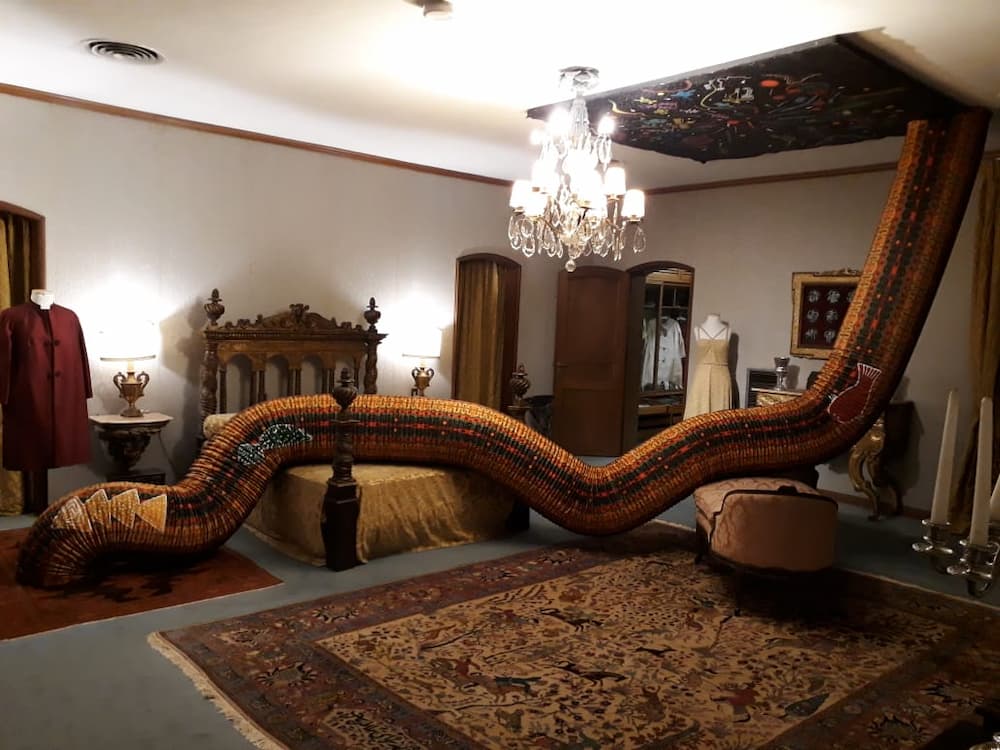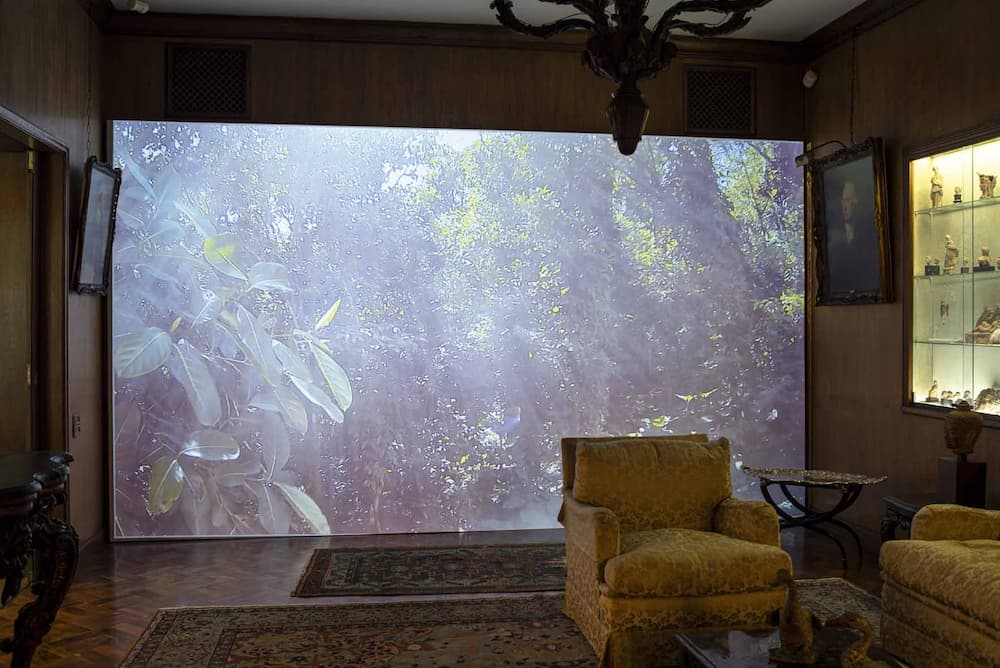Curated by Marcio Doctors and Paula Alzugaray, the interventions that take over the Eva Klabin House Museum show the strong impulse of the new order of contemporary art
The Eva Klabin House Museum inaugurates day 17 September (Saturday) from 17h, to 25th edition of the Breathing project with exhibition indigenous becoming, of the award-winning artists Denilson Baniwa and Gustavo Caboco. In the year in which ephemeris such as the 200 years of Brazilian independence and the 100 years of the Modern Art Week of 1922, bringing the language and creative energy of the original matrices are of relevant importance.
“If, in the invention of modern art, Western art has borrowed the form of the matrices of indigenous and African peoples to formally reinvent itself and express itself., without giving them the right voice; today, it is the native peoples of indigenous and African origin and those marginalized by the society of patriarchal power who borrow the form of contemporary art to express themselves. Your voices are heard today. It is a spiritual achievement that rearticulates the ethical relationships of our society based on aesthetics.”, says Marcio Doctors, curator of the Eva Klabin House Museum and who shares the curatorship of the exhibition comPaula Alzugaray
The Breathing Project started in 2004 with the aim of creating contemporary art interventions in the classical art environment of Eva Klabin House Museum, creating a contrast between the consecrated art of the past and the art of today. The idea of this edition was to allow direct contact with the artistic expression of the Baniwa and Wapichana peoples., in order to give them a place for speech and expression. It's not about speaking, how did the modern art week of 22, but make their voices heard.
“One cannot think about the contemporary world without taking into account the adherence that these ideas produce in our way of seeing, feel and perceive the world. It was from this perception that Denilson Baniwa and Gustavo Caboco were invited to participate in the 25th edition of Projeto Respiração. His interventions brought anima to the fossilization of the present, triggering a powerful reflection on the experience of time at the Eva Klabin House Museum and in our society”, complements Marcio Doctors
“Contemporary indigenous art has been relativizing codes, canons and certainties that western art tried to naturalize. Caboco and Baniwa cross Casa Eva Klabin with the power to make us review concepts, words and the language used to dialogue with art. The kinship relationship is among these concepts that assume diverse and complex connotations among native peoples.. Although it has specifics, this bond can gain a broader subjective and affective dimension, articulating itself around the cultural and political project of formation of a great community. So, instead of thinking of the interventions of the two artists in this space as individual actions, or even as a collective project, we can think of an exhibition woven by ties between relatives”, contextualizes the critic and curator Paula Alzugaray
The exhibition
It all started with a survey of the space of the house and its surroundings.. In this discovery exercise, the two artists visited the woods behind the house Eva Klabin Museum, Rodrigo de Freitas Lagoon, the Court of Cantagalo, the collection and the technical reserve of the house. With women, from water, of stone and art were extracting their perceptions.
Denilson Baniwa takes the forest inside the house Eva Klabin Museum through a real-time projection. This projection generates a caterpillar, that crosses different environments of the house, as a commentary on the passage of time of construction and reconstruction (ovo | caterpillar | chrysalis | butterfly). The tokotó-xeni caterpillar is of great importance to the Baniwa because during the rainy season – which corresponds to the period in which the intervention was carried out – the roots of the trees rot and when the caterpillar appears to eat the leaves, she arrives to announce that the land is ready for planting. The appearance of the caterpillar is the harbinger of change, but of a living change, that metamorphoses into different ways of existing in time, in its form and in the occupation of space. There is in this layer of meaning, brought into the house, a similarity with the proposal of the Breathing Project, which is to create creative layers with changes in the space of the house, establishing another temporality, that questions us about the passage of time and its crystallization implicit in the idea of a museum.
The caterpillar ends its path when it meets the cosmo-painting on the ceiling of Eva Klabin's room. It is born from a projected image and escapes through a painting towards the cosmos.. Creates a circularity and a union between the transformation of space and time of creation. By reconfiguring the space, establishes the changing time of creation. The caterpillar is laying its eggs, that turn into Cocoon Stones bred by Gustavo Caboco.
“The emotional relationship with the space was very inspiring. I intend to reflect this relationship, the house that was once a residence and today is something else, the change of the landscape in the surroundings, the transformation of the landscape, of the city and how we relate to these transformations”, says Denilson Baniwa
The creative articulation of Gustavo Caboco's intervention was based on two ideas. The first was the idea of cutting, present in the appointment of the Court of Cantagalo, next to Casa Eva Klabin, which connects Copacabana to Lagoa. A stone that was cut, whose extracted earth is found, today, at the bottom of the pond. He wonders if what was once the top of the hill is now the bottom of the pond? Launches a perception contrary to the logic of efficiency, that makes us reflect on how we naturalize these interferences in the geography of cities. For him it's like we've amputated the landscape, it's like taking a piece of a being. These displacements, physical and mental, in landscape manipulation, provoke a reflection on how the rearticulation of space takes place, the memories that are being drowned out (left aside) and the memories that are being produced by the changes of man's action in nature.
“A The idea is to provoke an exercise on the historical question of the environment, of memory and transformation. To provoke reflection on the idea of separating man from nature. Reflect on these questions, not with a metaphorical look, but to recognize what kind of relationship we have with the environment in which we live” , says Caboco.
The second idea came about when Gustavo Caboco discovered a fish fossil in the technical reserve, finding, at this moment, the poetic fuse that his sensibility needed to create the coalescence between his perceptions, artistic complicity with Denilson Baniwa, Breathing and the space of the house. A fossil is a stone cut in half (Cantagalo court), which brings the archaeological memory of the fish encrusted in it, which was marketed as souvenir, in the tourist shops of Copacabana in the years 80 (in the same way that native peoples were treated for many centuries as a souvenir of humanity). The memory is alive in stone. Is not souvenir. It's not a trophy of the past; it is living and pulsating time. That's what art is about.
the intervention indigenous becoming deals with the texture of time and space in the body of the house. The common thread of occupation is transformation and memory. Indicates that what is fragile is reality, not the imagination, art partner, that has the concreteness of the body and is guided by the dream language, that communicates with the drives of duration and becoming; it is with this substrate of the potency of life, that art establishes a direct contact. Denilson Baniwa and Gustavo Caboco create based on this bundle of sensations. Description of the intervention process, described by caboco, is revealing: “One dream was talking to another. Denilson dreamed of a caterpillar and I dreamed of a pond. In this pond there was a stone cut in the middle and it sent me to the fossil. It was a listening process”. Expanded memory is located, through the dream language, with imagination to weave new shapes. This texture is the poetic.



The artists:
Denilson Monteiro Baniwa: visual artist and curator. He composes his work crossing the visual languages of the western tradition with those of his people, using performance, painting, laser projections, digital images. He is known as one of the most important contemporary artists today for breaking paradigms and opening paths to the role of indigenous people in the national territory.. Activist, addresses the issue of the rights of indigenous peoples. It is indigenous to the peopleBaniwa. Was born in 1984 to the village of Darí, barcelos, Amazonas. Currently lives and works in Niterói, Rio de Janeiro.
“Sometimes the challenge is not to occupy positions. For example, when the ones that exist don't work, it is necessary to create something new”.
Gustavo Caboco, born in Curitiba, Roraima (1989). Visual artist Wapichana, works on the Paraná-Roraima network and on the return paths to the land. Your production with document drawing, painting, text, embroidery, animation and performance propose ways to reflect on the displacements of indigenous bodies, the recovery of memory and autonomous research in museum collections to contribute to the struggle of indigenous peoples.
The Trustees:
Marcio Doctors
He is an art critic and curator of the Eva Klabin House Museum. Creator and curator of the Breathing Project and creator of the Permanent Installations Space at the Museu do Açude, of which he was curator. He was Mario Pedrosa's private secretary and critic of the visual arts column of O Globo.. He is a Master in Aesthetics from UFRJ and curator of numerous exhibitions. He is the author of the books Breathing Project (2012) and Breathing: 10 years (2014).
Paula Alzugaray is curator, art critic and journalist specializing in visual arts. Post doctoral student in History, Criticism and Theory of Art at the School of Communication and Arts at the University of São Paulo. She is editor-in-chief of the contemporary art and culture magazine seLecT, that in the year of 2021 carried out a comprehensive research on the artistic production of the Amazonian peoples. She is the author of the book “Regina Vater: Four Ecologies” (Hi Future/Phase 3, 2013).
Breathing Project indigenous becoming
Sign up to receive Event News
and the Universe of Arts first!
Denilson Baniwa and Gustavo Caboco.
Opening: Saturday, 17 September, 17 at 9:00 pm (free entry)
Exhibition: from 18 September to 20 November
From Wednesday to Sunday, de 14h as 18h
EVA KLABIN HOUSE MUSEUM
Av. Pessoa, 2.480 -Pond, RJ
Tels:3202-8551 | 3202-8550
Prices and types of tickets:
One piece: R$ 20,00 – Half student/elderly: R$ 10,00
Free: Public network teachers, Public network students, Children of 0 to 5 years, People with disabilities and PCD Companion
Ticket sales website: casamuseuevaklabin.byinti.com/#/ticket/
